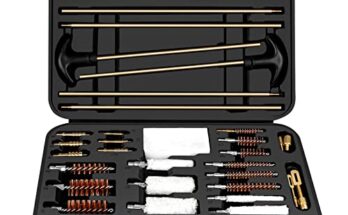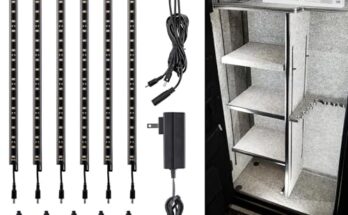To fit a bipod to an air rifle, follow these steps: first, choose a compatible bipod model. Then, attach the bipod to the sling swivel stud on the forearm of the rifle.
When it comes to enhancing the stability and accuracy of your air rifle, fitting a bipod is a practical solution. Whether you’re a seasoned shooter or a novice hunter, a bipod provides excellent support and enables steady aiming. In this guide, we will walk you through the simple process of fitting a bipod to your air rifle.
By following these steps, you can ensure a secure attachment and start enjoying the benefits of having a bipod on your air rifle. So, let’s get started and learn how to fit a bipod to an air rifle in a few easy steps.
Choosing The Right Bipod
When it comes to enhancing the stability and precision of your air rifle, choosing the right bipod is crucial. A bipod is a valuable accessory that provides the necessary support for steady shooting, whether you’re hunting or engaged in target practice. But with a variety of bipods available on the market, it’s important to consider a few key factors before making your selection.
Consider The Rifle’s Weight
One of the first things to keep in mind when choosing a bipod for your air rifle is the weight of the rifle itself. Different air rifles come in various sizes and weights, so it’s essential to select a bipod that can handle the weight without affecting the rifle’s balance.
Some bipods have weight limitations, so make sure to check the manufacturer’s specifications before making your purchase. A bipod that is not designed to support the weight of your air rifle may compromise its stability, accuracy, and even lead to potential damage.
Selecting The Proper Mounting Style
Another important consideration when selecting a bipod is the proper mounting style for your air rifle. Bipods typically come in two main mounting styles: swivel and fixed. Each has its own advantages and is suitable for different shooting situations.
Swivel bipods provide rotation, allowing you to adjust your rifle horizontally, enabling smooth tracking of moving targets. This flexibility is particularly beneficial for hunting scenarios where targets may be on the move.
Fixed bipods, on the other hand, offer increased stability and rigidity, making them perfect for precise shooting during target practice or long-range shots. These bipods are generally easier to use and require less adjustment.
Consider your shooting style and the intended purpose of your air rifle to determine which mounting style will best suit your needs.
Additionally, it’s worth noting that some bipods offer a quick-detach feature, allowing you to easily remove and attach the bipod as needed. This can be particularly beneficial when transitioning between different shooting positions or when you prefer to shoot without the bipod attached.
In Summary
When choosing a bipod for your air rifle, it’s important to consider the weight of the rifle to ensure the bipod can handle it without compromising stability. Additionally, selecting the proper mounting style that suits your shooting style and purpose will enhance your shooting experience. Take the time to assess your specific needs and preferences to find the ideal bipod for your air rifle.
Gathering Necessary Tools And Equipment
Before you can start fitting a bipod to your air rifle, it’s important to gather the necessary tools and equipment. This ensures that you have everything you need at hand and can complete the job smoothly. In this section, we’ll take a look at the essential tools and bipod-specific equipment you’ll need.
Essential Tools
Here are the must-have tools that you should gather before starting the bipod fitting process:
| Tool | Description |
|---|---|
| Screwdriver | A screwdriver will be needed to remove any existing parts or accessories from your air rifle. |
| Allen wrenches | Various sizes of Allen wrenches will be required to tighten screws and secure the bipod in place. |
| Torque wrench | A torque wrench is essential to ensure that all nuts and screws are properly tightened to the manufacturer’s specifications. |
| Threadlocker | Using a threadlocker is advisable to prevent screws from loosening over time due to the recoil of the air rifle. |
Bipod-specific Equipment
In addition to the essential tools, there are specific equipment items that will be necessary for fitting a bipod to your air rifle:
- Bipod mount: This is the device that attaches the bipod to your rifle. The type of mount you choose will depend on the specific model of your air rifle and the type of bipod you have.
- Adapter: If your air rifle does not have a built-in sling swivel stud for attaching the bipod, you will need an adapter to provide a suitable attachment point.
- Bipod: Of course, you’ll need the bipod itself. Choose a bipod that is compatible with your air rifle and offers the desired adjustments and stability.
- Bench vise or gun vice: Having a vise or gun vice will help keep your air rifle steady during the bipod fitting process, ensuring accurate installation.
By gathering these essential tools and bipod-specific equipment beforehand, you will be well-prepared to fit a bipod to your air rifle with ease. In the next section, we’ll look at the step-by-step process of attaching the bipod securely.
Preparing The Rifle For Bipod Installation
To ensure a successful installation of a bipod on your air rifle, it’s crucial to properly prepare the rifle. This involves ensuring the rifle is unloaded, properly securing it, and taking necessary precautionary measures. Below, we’ll walk through the essential steps to prepare your air rifle for the fitting of a bipod.
Ensuring The Rifle Is Unloaded
Before beginning the installation process, ensure the air rifle is completely unloaded. This means both checking the magazine and the chamber to make sure there are no rounds present. Keeping the rifle unloaded throughout the installation process is vital to prevent accidental discharge and ensure safety.
Properly Securing The Rifle
Once the rifle is confirmed unloaded, the next step is to secure the rifle in a proper position. This can be achieved by placing the rifle on a flat and stable surface, such as a table or workbench. It’s important to ensure a stable base to avoid any unintended movements during the installation process.
Attaching The Bipod To The Rifle
Mounting Process For Different Bipod Styles
When attaching a bipod to an air rifle, the mounting process may vary depending on the style of the bipod. Below are the steps for attaching different bipod styles:
- Before starting, ensure the rifle is unloaded and the safety is engaged.
- Swivel Bipod: Attach the swivel bipod to the stud on the rifle’s forend. Secure it in place with the provided fastener.
- Picatinny Bipod: Slide the Picatinny bipod onto the Picatinny rail and tighten the locking mechanism to secure it.
- Harris-Style Bipod: Install the Harris-style bipod by attaching the bipod adapter to the rifle’s swivel stud and then attach the bipod to the adapter.
Adjusting The Bipod Legs
Once the bipod is attached to the air rifle, it’s essential to adjust the bipod legs for optimal stability and shooting position. Follow these steps:
- Extend or retract the bipod legs to the desired length to accommodate different shooting conditions.
- Secure the leg extensions in place using the locking mechanisms to prevent any unwanted movement during shooting.
- Ensure the bipod legs are even in length to maintain balance and stability while aiming and firing.
Testing And Adjusting The Bipod
Fitting a bipod to your air rifle is essential for stability and accuracy. Once the bipod is attached, the next step is Testing and Adjusting it for optimal performance.
Stability And Levelness Check
Ensure your rifle is stable and level by adjusting the bipod legs accordingly. A stable foundation is crucial for accurate shooting.
Fine-tuning For Comfort And Accuracy
Fine-tune the bipod height and leg position for maximum comfort and precision. This adjustment can greatly enhance your shooting experience.
Maintaining And Caring For The Bipod
Proper maintenance and care of the bipod are essential for ensuring its longevity and optimal performance. By following a few simple practices, you can keep your bipod in top condition, helping to enhance the stability and accuracy of your air rifle. Here’s how to effectively maintain and care for your bipod:
Cleaning And Lubricating The Bipod
Regularly clean your bipod to prevent the accumulation of dirt, dust, and debris. Use a soft, clean cloth to wipe down the legs, feet, and locking mechanisms. For thorough cleaning, disassemble the bipod as per the manufacturer’s instructions and use a mild cleaning solution to remove any buildup. Lubricate moving parts with a suitable gun oil to ensure smooth operation and to prevent rust and corrosion.
Regular Inspection And Tightening Of Components
Periodically inspect all components of your bipod for signs of wear, damage, or loosening. Check the leg hinges, locking nuts, and screws to ensure they are secure and functioning properly. If any parts appear worn or damaged, replace them as soon as possible to maintain the stability and reliability of the bipod. Tighten any loose components using the appropriate tools to prevent any potential issues during use.
Frequently Asked Questions On How To Fit A Bipod To An Air Rifle
How Do I Choose The Right Bipod For My Air Rifle?
Select a bipod that fits your rifle’s attachment type and weight capacity, enhancing stability and accuracy.
What Are The Benefits Of Using A Bipod On An Air Rifle?
A bipod improves shooting accuracy, stability, reduces fatigue, and provides a comfortable shooting position for better precision.
How To Properly Attach A Bipod To An Air Rifle?
Ensure your rifle’s forend has a swivel stud or Picatinny rail for attachment. Securely mount the bipod for stability and efficiency.
Conclusion
To sum up, fitting a bipod to an air rifle is a straightforward process that can significantly improve accuracy and stability. By following the steps outlined in this guide, you can enhance your shooting experience and maximize the potential of your air rifle.
With the right equipment and proper installation, you’ll be ready for more precise and enjoyable shooting sessions.

